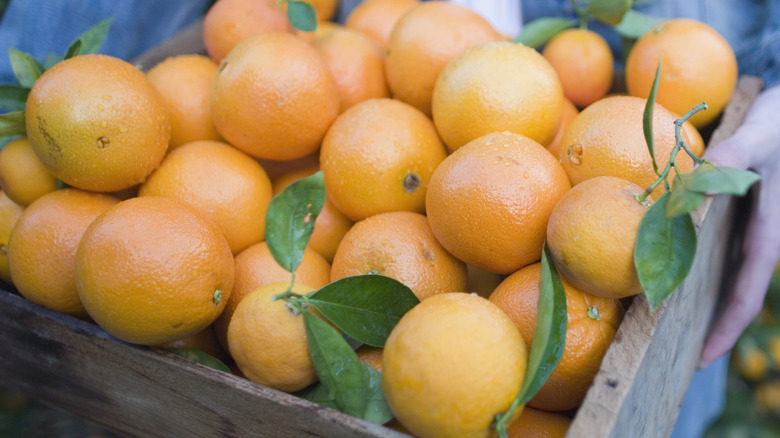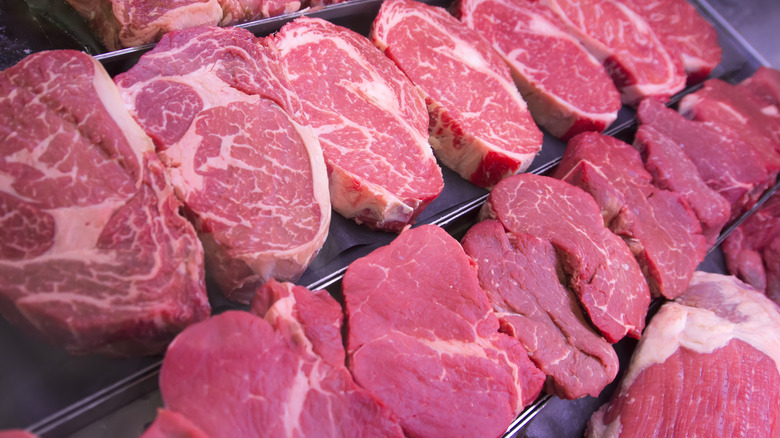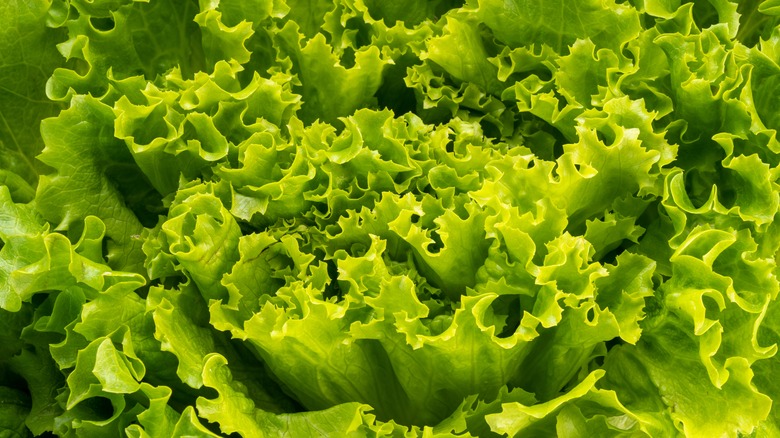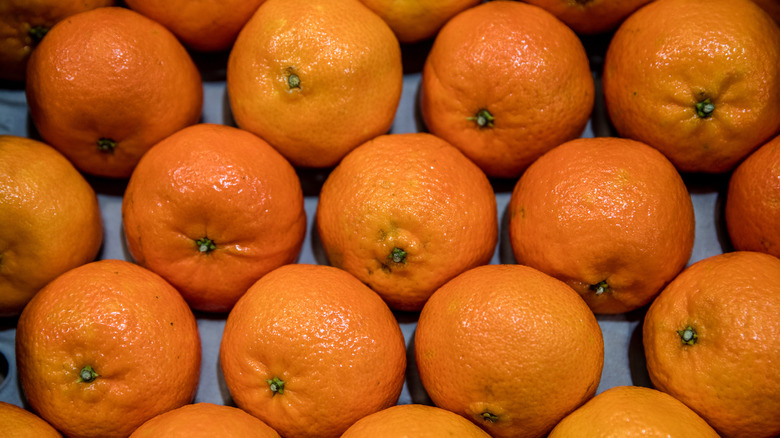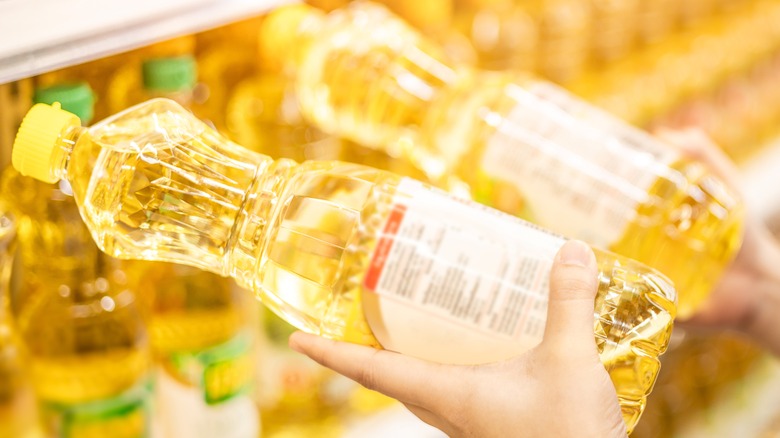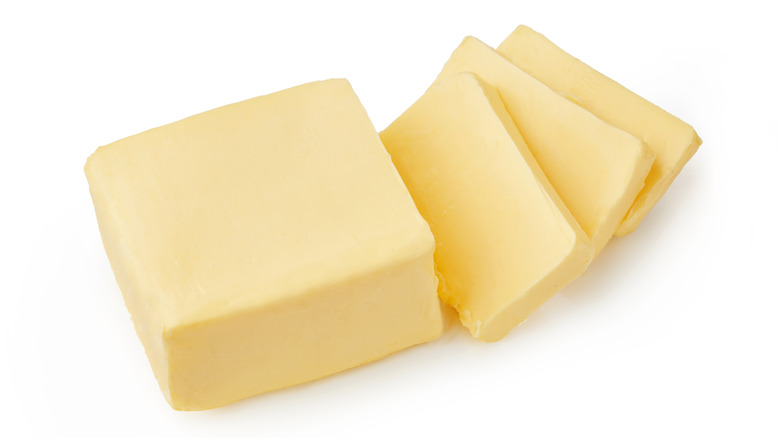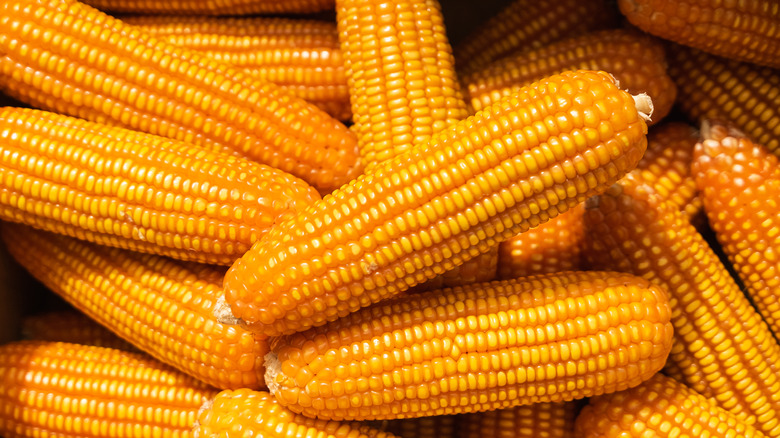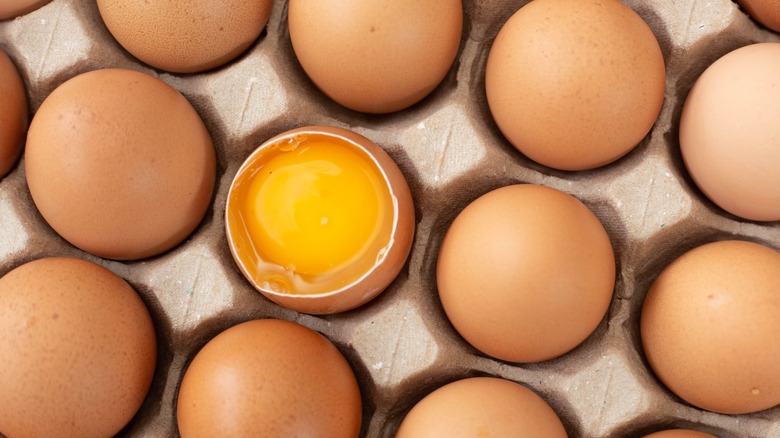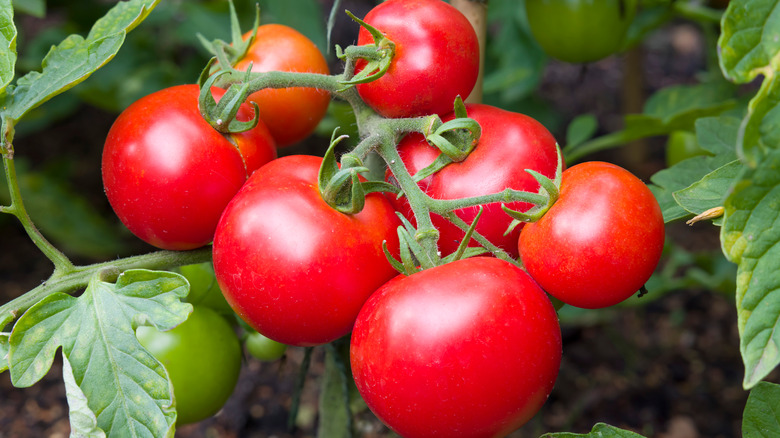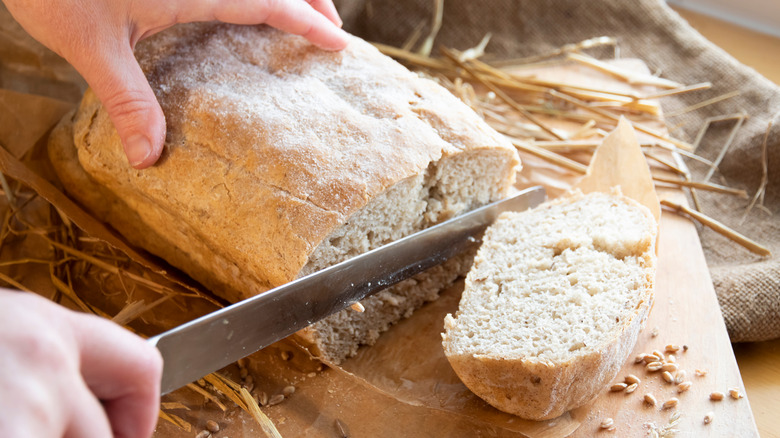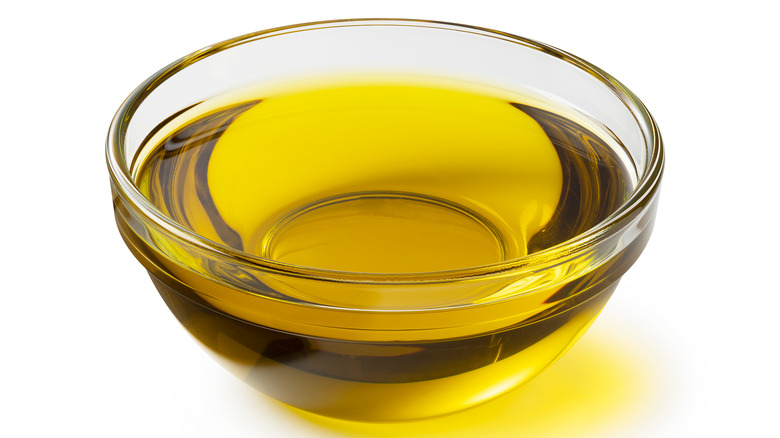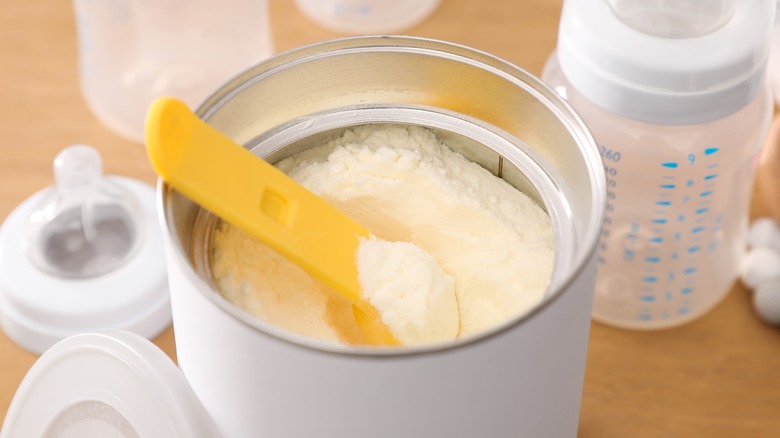The 13 Food Shortages To Expect In 2023
The United States in the 21st century is a place of abundance. We've come to expect almost every possible item, including food, and especially staple items, to be available at every corner market, supermarket, and warehouse store virtually any day of the year, and often at any time of day. That's all thanks to a robust and intricate supply chain that ensures products are available almost always, without interruption. And while that system is pretty reliable for the most part, sometimes real life events create disruptions and wreak havoc on the food supply, with the effects rippling out for years afterward.
So far, in the 2020s, farmers, food processors, suppliers, and grocery stores have been affected by weather problems, diseases, and labor shortages (or even all three factors and then some), which contributed to surprisingly empty store shelves at times. The lasting consequences of plant illness, animal disease, drought, climate change, and the COVD-19 pandemic all but ensure shortages of some important food items in the coming years. Read on to discover some of the things experts say may be hard to come by in 2023.
1. Beef
Beef, according to its producers' marketing slogan, is what's for dinner. And that's often true for many, whether it be it in the form of hamburgers, a roast, ribs, or steak. But in 2023, beef is likely to be in short supply, forcing Americans to get their robust protein fix and dietary centerpiece from something other than red meat.
According to Beef Magazine, the USDA estimates that the average American will consume 5.6% less beef in 2023 than they did in 2022 — the steepest decline in consumption in nearly 40 years. Consumers' choice to buy less beef is related to economic concerns, such as inflation, lackluster GDP growth, and escalating beef costs brought on by an ongoing shortage of the meat. According to the Washington Times, a devastating drought in Texas, which is responsible for 14% of the U.S. beef supply, led to a lack of grass feed for cows. Meanwhile alternative feeds are currently too expensive to be cost effective. All this resulted in early culls and slaughter of cows meant to be processed in 2023. So as ranchers catch up, consumers can expect a nationwide shortage of beef products of every kind.
2. Lettuce
Lettuce, that crisp and leafy green that serves as the basis for countless salads and tops numerous sandwiches, was harder to find than usual in the United States in 2022. The reasons are twofold, with weather and some virulent plant diseases working in concert to cause significant and successive blows to the lettuce crop in California, where most of America's supply is grown.
According to the Grower-Shipper Association of Central California, the region in and around the agricultural cradle of Salinas experienced multiple unseasonable periods of warm weather, which upset and scorched lettuce plants. Weakened by unsuccessfully trying to fight off the effects of heat, the lettuce crop was left vulnerable to disease. And that's when Impatiens Necrotic Spot Virus (INSV) struck. Insects called thrips introduce the disease to lettuce crops. It manifests as spotting and discoloration. And after INSV hits, it's often followed by Pythium wilt, making the lettuce saggy, unpalatable, and unsellable. This combination of weather and multiple plant diseases has made for much less available lettuce, creating a shortage set to last into 2023.
3. Beer
It's not just foods that face scarcity in the months to come — beverages do, too. A possible and looming shortage of beer in 2023 isn't necessarily because of the difficulty in growing or obtaining the raw ingredients needed to make the alcoholic beverage. Empty beer shelves might be a problem in the coming months due to a lack of the materials used to carbonate and package the drink.
According to WKMG News, the demand and need for aluminum blew up during the early months of the COVID-19 pandemic, as millions shifted to drinking beer at home instead of at bars or in breweries. Pet adoption rates also drastically rose, and canned pet food companies used up a lot of the available aluminum. With stocks already depleted, China issued a reduction in aluminum processing to cut down on pollution, reducing the overall global production rate, and thus supply, of aluminum by as much as 20%.
A shortage of cans isn't the only problem, though. A key ingredient in making beer is the addition of carbon dioxide. The bubbling agent is also harder to obtain than it was a few years ago. According to Axios, carbon dioxide is a solid form of dry ice, which was heavily utilized for the shipping of COVID-19 vaccines. Already stymied, the carbon dioxide supply chain suffered more damage when a major production facility in Mississippi became contaminated by a nearby volcano in September of 2022.
4. Champagne
According to European law, real Champagne must be grown, fermented, and bottled within 100 miles of the Champagne region of France (via Wine Country). Otherwise, it's simply sparkling wine. But the real stuff could be in short supply in 2023.
France's Comité Interprofessionnel du Vin de Champagne (CIVC) regulates the French champagne industry, which includes setting annual production limits. Wine Enthusiast reports that demand for the traditionally celebratory beverage dropped by 18% in 2020, likely linked to the bleak state of affairs caused by the COVID-19 pandemic and the widespread lockdowns experienced around the world. That year, the CIVC called for a 25% reduction in Champagne production. But then 2021 rolled around and people started buying a lot more Champagne. That increase in demand outpaced the supply, in part due to the CIVC's limits, and because it takes at least 15 months to make a proper bottle. The effects of supply, demand, and production limits are thus felt for years, and the pandemic-era fluctuations will limit champagne availability into 2023.
Weather problems have also played a role in the Champagne shortage. In March 2021, a heat wave in the Champagne region followed by an unseasonal period of frost destroyed grapevines. Higher than usual levels of rain in the summer then created a devastating mildew. The subsequent harvest of Champagne grapes wound up being the lowest in decades.
5. Oranges
According to the Florida Department of Citrus, that state is one of the world's most prolific regions for growing oranges and producing orange juice. The Florida climate usually provides ideal citrus conditions, including near-tropical temperatures, plenty of rain and sun, and sandy soil. But when that weather gets even a little out of whack, it can lead to catastrophic effects on Florida's orange crop — a situation playing out in 2023, according to Bloomberg.
In 2022, Hurricane Ian and Tropical Storm Nicole brought high winds and torrential rains, destroying the Florida orange crop. That followed an epidemic of citrus greening, a plant disease that makes oranges fall off branches before they're ready, producing a bitter-tasting fruit. While oranges are still hitting produce departments in American grocery stores — from California and Brazil, where weather has also led to a production decline — the issues in Florida are the biggest cause of a shortage. In the October 2022 to September 2023 season, Florida farmers are expected to produce 20 million boxes of the fruit, 51% less than the previous season. That makes for the biggest drop since 1913, and the lowest overall harvest since 1937.
6. Cooking oil
There's a certain category of commercial agriculture called oilseed crops, which collectively make up the raw materials used to make cooking oils. Among oilseed crops are soybeans, sunflowers, peanuts, rapeseed, and canola, according to the U.S. Department of Agriculture, which are processed into millions of bottles of fatty plant oil used to cook our food. The vast majority of oilseed crops are harvested in Russia and Ukraine — the Brookings Institution reported that more than 70% of the world's sunflower seed and sunflower oil alone in 2020 originated in those two countries, which, as of 2022 and into 2023, are at war with one another. With those countries preoccupied by the military conflict, Time reports that exports will be way down, leading to shortages of cooking oil and higher prices for what remains available.
Making matters worse is Indonesia, the world's leading producer of palm oil. The country temporarily banned exports of the product in April 2022 (per Agri-Pulse). After settling on a rule to limit exports — producers had to keep one ton in the country for every eight shipped out (via Economic Times) — the Indonesia government cut that ratio down to one ton staying at home for every six exported. That makes for a 25% decrease in palm oil shipments.
7. Butter
Refrigerated butter shelves in supermarkets aren't suddenly going to turn empty — the United States has been enduring some supply and cost issues with butter since the last few months of 2022. According to the Consumer Price Index, inflation on consumer goods led to a 9.1% average price hike in 2022, with food costs rising by more than 12%. While a range of issues is responsible for this economic crisis in general, butter experienced one of the steepest price upticks, specifically due to a lengthy labor shortage in the dairy farm sector and a subsequent reduction in milk production. Less work means less milk, which in turn means a lot less butter. According to the Wall Street Journal, the overall butter supply is the lowest it's been since 2017.
Holiday feasting and baking at the end of 2022 led to a natural run on the nation's majorly reduced butter stocks, so that shortage is likely to extend into the early months of 2023. According to Farmers Advance, milk production is likely to increase somewhat in 2023, but it will take a while before farmers and food corporations can process it into sellable butter.
8. Corn
Corn is the single most lucrative cash crop in the United States. The production, distribution, and sale of corn contributed $71.1 billion to the American economy in 2021, according to the U.S. Department of Agriculture. Whether it's used to make oil, high fructose corn syrup, canned, or sold fresh on the cob or off, corn is an extremely versatile and important product.
The industry and its regulators keep a close watch on how much corn is produced, and in 2022, according to the USDA, farmers were set to plant 89.5 million acres of crops, about 4% less than they had in 2021. That means corn farms were set to produce 3.7 million fewer acres of the cash crop, making for a significant dent in the overall corn supply. This could very well and logically mean a dearth of corn and corn-based products on store shelves in 2023, along with higher prices on what is produced, according to Successful Farming.
9. Eggs
One could argue that eggs are literally the glue of the American diet. They're a binder and ingredient in a vast variety of baked goods, as well as a protein-rich breakfast and brunch staple, be they scrambled, fried, poached, or made into a quiche or omelet. Unfortunately, a nationwide egg shortage is set to interrupt breakfast plans for millions in 2023 (via The New York Times).
The severe lack of eggs expected in 2023 is a direct result of one of the biggest avian flu outbreaks in American history in 2022, as reported by the Centers for Disease Control. By the end of that year, bird flu led to the deaths of more than 49 million birds across 46 states, either directly from the virus itself or from culling by farmers after confirmed exposure to the disease. Since eggs come from chickens, the lack of millions of producers significantly affects the supply, as do preexisting supply chain issues brought on by the pandemic and increasing labor costs, according to the Washington Post. And the eggs from healthy hens that did make it to stores cost way more than usual. In California in early 2023, a dozen eggs carried a price tag of three times what they did in early 2022.
10. Tomatoes
It's highly likely that the produce in the average American kitchen originated in California. In 2021, according to the state's Department of Food and Agriculture, a third of the nation's vegetables and 75% of its fruit and nuts came from the Golden State. By and large, California offers wonderful weather and growing conditions for crops. But if there's a drought, that can create cataclysmic effects on the food supply. And according to the Los Angeles Times, that's exactly what's happened in the 2020s — California is in the midst of the driest three-year period in recorded history. In a single week in October 2022, 94% of the state experienced serious drought conditions, reports Fox Business.
The U.S. Department of Agriculture reported in August 2022 that the lack of rain could prove particularly terrible for tomato farmers. Production forecasts dropped by 2% over the 2021 yield, which could lead to way less tomatoes available in 2023, not to mention all the products made with tomatoes, such as ketchup and pasta sauce.
11. Bread
The Russian invasion of Ukraine and subsequent and ongoing war was one of the biggest global news stories of 2022. It's still waging in 2023, and its ramifications will be felt in the food world and beyond. According to the Brookings Institution, about 20% of the world's cereal grain production — namely wheat —comes from those countries, whose large-scale farming operations remain interrupted. With that large of a portion of the wheat business out of the game for the time being, that's likely to result in a shortage of things made from wheat, like bread. Exports resumed in November 2022, according to Bloomberg, but it could take time for the wheat supply to return to pre-war levels.
Not only will the Eastern European conflict likely lead to bread scarcity, but so will climate change (via Nature). According to The Conversation, rising temperatures are decreasing yields of cash crops around the world, including wheat earmarked to make bread.
12. Olive oil
It can take many months to meet demand for globally popular foods that are grown on a large scale in a handful of regions. That's why it became evident as early as the summer of 2022 that an olive oil shortage was in the cards for 2023. According to Atlas Obscura, the issue was foreshadowed in 2010, when a tree-blighting bacteria of Latin American origin called Xylella fastidiosa surfaced and made its way to the Puglia region of Italy, where 12% of the world's olive oil supply is produced. By 2021, Xylella had infected a solid third of the area's 60 million olive trees, making the fruit unusable before completely killing the tree itself.
The bacteria is the cause of a 50-70% olive oil production reduction since it took hold, and it's a problem that in all likelihood will last beyond 2023 (per Olive Oil Times). This year, according to Bloomberg, worldwide olive oil production will drop by 11%, on account of the Puglia crisis and a plant-hampering 2022 heat wave in Spain, another olive oil hotbed.
13. Infant formula
Baby formula is a modern scientific marvel, a synthetic re-creation of natural, nutritionally-dense breast milk, and it's what millions of babies in their first year of life literally subsist upon. In February 2022, Abbott, the U.S.'s largest infant formula manufacturer (they make Similac, Alimentum, and Elecare), temporarily halted production and issued a massive recall when they discovered bacteria at a facility, reports CNBC. By May 2022, a full-on shortage was in effect, with more than 40% of the usual stock unavailable. Big retailers like CVS and Target issued purchase limits, and the White House intervened with Operation Fly Formula, obtaining and quickly distributing reserves of the vital food constituting more than 13 million servings.
The shortage, while not in such a critical state as was the case earlier in the year, continued through 2022, according to Reuters. It will likely remain in effect into the middle of 2023. Reckitt Benckiser, manufacturer of formula market leader Enfamil, announced that while many companies had increased production, it still wouldn't be enough to stabilize the market,or get stock to 2021 levels.
